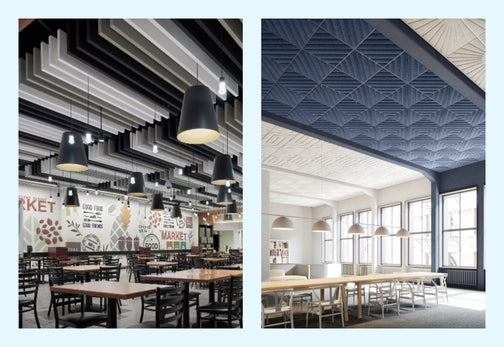Fire-rated ceiling tiles give occupants more time to get out

If a fire breaks out in a building, preventing its spread and giving people time to escape are the highest priorities. According to the National Fire Protection Association (NFPA), a fire department in the U.S. responded to a fire every 21 seconds in 2022.
Fire-rated ceiling tiles are not just important—they are often a necessity. The requirement for fire-rated ceiling tiles varies by building type. While residential buildings may not always require them, codes for fire-resistant commercial buildings mandate their use. When building or renovating, it is essential to consult with your local fire marshal or inspector to ensure compliance with appropriate codes and the installation of the correct materials.
What are fire rated ceiling tile materials and what does the rating mean?
A fire-resistant ceiling assembly is rated by the period of time a building element, component or assembly maintains the ability to confine a fire, continues to perform a given structural function, or both. It is classified by the amount of time it fully performs, being 1-hour, 2-hour, 3-hour, and 4-hour ratings. Armstrong’s Fireguard products are often used as part of such assemblies.
The ASTM E84 test Standard classifies materials based on their reaction to fire and surface burning characteristics. It measures flame spread and smoke development. The material classification is broken into three categories as seen below:
Class A
• Flame spread of 25 or less, smoke developed of 0-450.
• Flame spread of 25 or less, smoke developed of 50 or less, if used as part of an air handling plenum.
Class B
• Flame spread of 26-75, smoke developed of 0-450.
Class C
• Flame spread of 76-200, smoke developed of 0-450.
What is the fire performance of Armstrong ceiling tiles?
Most Armstrong ceiling tiles are classified as Class A. Armstrong’s Fireguard products can be used as part of fire-rated assemblies. Armstrong’s Fire Guard Grid Systems have patented expansion relief to help maintain the structural integrity of the ceiling.
Look for the below icons for Class A products and FIRE GUARD materials.
Fire Performance: Class A
The flame spread rating of a material refers to how well the flame spreads on the surface of the material. Flame spread of 25 or less, smoke developed of 0-450. Class A products have a flame spread of 25 or less, and smoke developed of 50 or less, if used as part of an air handling plenum.
FIRE GUARD
Fire guard products are engineered and tested as part of a fire-resistant system, which includes all components of the system including the ceiling tiles, grid, and the structure itself. The performance of the fire-rated assembly can be listed as 1-hour, 2-hour, 3- hour, and 4-hour ratings.
Are ceiling tiles fireproof?
Unfortunately, there is no such thing as fireproof ceiling tiles, however, ceiling products with Class A fire performance prevent the spread of fires and limit the production of smoke. In addition to that, Armstrong Fireguard products provide an additional level of performance and can withstand severe fire exposure. This is important because it can help preserve as much of the building as possible, allow occupants to evacuate, and building functions to remain in service longer. It also helps to compartmentalize the fire and prevent the spread of fire to other areas of the building or neighboring buildings.
Protect your space
In the event of a fire, your ceiling materials can make a huge difference in the state of your building and the people in it. Stay safe and compliant! Connect with your local fire marshal or inspector to ensure you install the correct ceiling materials for your space.
Shop fire-rated ceiling tiles here.
-
Posted in
class a fire rating ceiling tile, class a fire retardant ceiling tiles, drop ceiling fire code, fire rated acoustical ceiling, fire rated ceiling panels, fire rated ceiling tiles, fire rated drop ceiling, fire rated drop ceiling tiles, fire rated suspended ceiling, fire rated suspended ceiling tiles, fire resistant ceiling panels, fire resistant ceiling tiles, fire retardant ceiling tiles, fireproof ceiling panels, fireproof ceiling tiles, fireproof drop ceiling tiles, heat resistant ceiling panels, heat resistant ceiling tiles





 Thanks for subscribing!
Thanks for subscribing!

